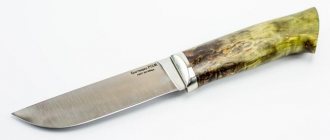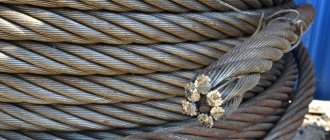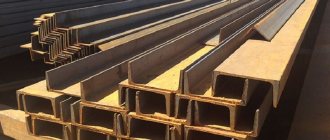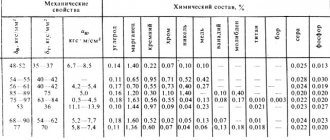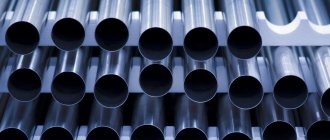8 years in the rolled metal market
We work with individual entrepreneurs, individuals, Management Companies and other organizations
We will deliver the products on time
Delivery throughout St. Petersburg and Leningrad region
There are more than 3,500 different grades of steel, each with unique physical, chemical and environmental properties. Essentially, the material consists of iron and carbon, as well as impurities and additional alloying elements. This article will be useful in determining which grade of steel is suitable for welded structures and connections, depending on the operating conditions of the part.
Types of steels and features of their markings
Various areas of application of steel require that it have strictly defined properties - physical, chemical. In one case, the highest possible wear resistance is required, in others, increased resistance to corrosion, in others, attention is paid to magnetic properties.
There are many types. The bulk of the smelted metal goes into the production of structural steel, which includes the following types:
- Construction Low alloy steel with good weldability. The main purpose is the production of building structures.
- Spring. They have high elasticity, fatigue strength, and fracture resistance. Used for the production of springs and leaf springs.
- Bearing. The main criterion is high wear resistance, strength, low fluidity. It is used for the production of units and components of bearings for various purposes.
- Corrosion resistant (stainless). High-alloy steel with increased resistance to aggressive substances.
- Heat resistant. It is distinguished by its ability to work for a long time under load at elevated temperatures. Area of application: engine parts, including gas turbine engines.
- Instrumental. Used for the production of metal and woodworking and measuring instruments.
- Fast cutting. For the manufacture of tools for metalworking equipment.
- Cementable. It is used in the manufacture of parts and assemblies operating under high dynamic loads under conditions of surface wear.
Steel classification
When deciphering the designations, it is necessary to take into account that each of the types corresponds to a strictly defined letter in the marking.
Characteristics of steel grade St3kp
St3kp - Structural carbon steel of ordinary quality, welds well, welding is carried out without heating and without subsequent heat treatment, welding methods: manual arc welding, automatic submerged arc welding and gas protection, KTS, ESW. For thicknesses greater than 35 millimeters, heating and subsequent heat treatment are recommended; it is prone to flake sensitivity, and there is no tendency to temper brittleness. Cutting machinability in the hot-rolled state at HB 124 and σ = 410 MPa. Kυ tv.sp. = 1.8 and Kυ b.st. = 1.6, has found its application in lightly loaded elements, in welded and non-welded structures and parts operating at temperatures from -40 to 400 degrees, used in shaped profiles for cars, used in the same way as class A-I (A240) fittings . Forging at temperatures from 1300 to 750 0C, cooling is carried out in air. According to GOST 27772-88, steel St3kp corresponds to steel for building structures S235
Classification by chemical composition
The main alloying additives are metals. By varying the quantitative composition of additives and their mass fraction, a wide variety of steel grades are obtained. Pure iron itself has low technical properties. Low mechanical strength and high susceptibility to corrosion require the introduction of additional substances into the alloy composition, which are aimed at improving one of the qualities, or several at once.
Often, the improvement of some characteristics entails the deterioration of others. Thus, high-alloy stainless steels may have low mechanical strength, while high-quality carbon steels, along with high strength, receive weakened corrosion properties.
As mentioned above, one of the classifications of steel grades is its chemical composition. The main components of all steels without exception are iron and carbon, the content of which should not exceed 2.14%. Depending on the amount and proportions of additives, the iron content in the composition should be at least 50%.
Based on the amount of carbon contained, steels are classified into three groups:
- Low-carbon – carbon content less than 0.25%;
- Medium carbon – 0.25-0.6% carbon;
- High carbon, with a carbon content of more than 0.6%.
An increase in the percentage of carbon increases the hardness of the metal, but at the same time its strength decreases.
To improve performance, a certain amount of chemical elements is introduced into the alloy. Such steels are called alloyed. For alloy steels there is also a division into three groups:
- Low alloy, containing additives up to 2.5%;
- Medium alloyed, which contain from 2.5 to 10% alloying elements;
- Highly alloyed. The content of alloying impurities varies from 10 to 50%.
The marking of steels reflects the presence and percentage of alloying additives. When deciphered, each element is assigned a specific letter, next to which there is a number corresponding to its content as a percentage. The absence of numbers indicates that the additive is present in the alloy in an amount of less than 1-1.5%. The presence of carbon in the composition is not reflected, since it is included in all compositions, but its content is indicated at the very beginning of the labeling.
The marking can also indicate the purpose of the alloy. Since this classification also uses letter designations, the order of their arrangement is regulated - at the beginning, middle and end of the marking.
Classification of alloy steels
Based on the carbon content of steel, it is divided into:
- low-carbon steels (up to 0.25% carbon);
- medium carbon steels (up to 0.25% to 0.65% carbon);
- high-carbon steels (more than 0.65% carbon).
Depending on the total amount of alloying elements that alloy steel contains, it can belong to one of three categories:
- low alloy (no more than 2.5%);
- medium alloyed (no more than 10%);
- highly alloyed (from 10% to 50%).
The properties of alloy steels are determined by their internal structure. Therefore, the classification of alloy steels implies division into the following classes:
- hypoeutectoid - the composition contains excess ferrite;
- eutectoid - steel has a pearlite structure;
- hypereutectoid - their structure contains secondary carbides;
- ledeburite - the structure contains primary carbides.
According to their practical application, alloyed structural steels can be: structural (divided into machine-building or construction), tool, and also steels with special properties.
Purpose of structural alloy steels:
- Mechanical engineering - used for the production of parts for various mechanisms, body structures, and the like. They differ in that in the vast majority of cases they undergo heat treatment.
- Construction - most often used in the manufacture of welded metal structures and are subjected to heat treatment in rare cases.
The classification of engineering alloy steels is as follows.
- Heat-resistant steels are actively used for the production of parts intended for work in the energy sector (for example, components for steam turbines), and they are also used to make especially important fasteners. Chromium, molybdenum, and vanadium are used as alloying additives. Heat-resistant steels refer to medium-carbon, medium-alloy, pearlitic steels.
- Improved steels (from the categories of medium-carbon, low- and medium-alloyed) steels, in the production of which hardening is used, are used for the manufacture of heavily loaded parts that experience variable loads. They differ in sensitivity to stress concentration in the workpiece.
- Case-hardened steels (from the categories of low-carbon, low- and medium-alloyed) steels, as the name suggests, are subject to carburization followed by hardening. They are used for the manufacture of all kinds of gears, shafts and other parts similar in purpose.
Dependence of the thickness of the cemented layer on temperature and processing time
The classification of construction alloy steels implies their division into the following types:
- Bulk - low-alloy steel in the form of pipes, shaped and sheet products.
- Bridge construction - for road and railway bridges.
- Shipbuilding cold-resistant, normal and high-strength - well resistant to brittle fracture.
- Shipbuilding cold-resistant high strength - for welded structures that will operate in low temperature conditions.
- For hot water and steam - operating temperatures up to 600 degrees are allowed.
- Low-cut, high-strength - used in aviation, sensitive to stress concentration.
- Increased strength using carbonitrite hardening, creating a fine-grained steel structure.
- High strength using carbonitrite hardening.
- Strengthened by rolling at a temperature of 700-850 degrees.
Application of tool alloy steels
Tool alloy steel is widely used in the production of various tools. But in addition to its obvious superiority over carbon steel in terms of hardness and strength, alloy steel also has a weak side - higher fragility. Therefore, such steels are not always suitable for tools that are actively exposed to shock loads. Nevertheless, in the production of a huge range of cutting, impact-stamping, measuring and other tools, alloy tool steels remain indispensable.
Separately, we can note high-speed steel, the distinctive features of which are extremely high hardness and red resistance up to a temperature of 600 degrees. Such steel is able to withstand heat at high cutting speeds, which allows you to increase the speed of metalworking equipment and extend its service life.
A separate category includes alloyed structural steels, endowed with special properties: stainless, with improved electrical and magnetic characteristics. Depending on what elements, as well as in what quantities, are predominantly contained in them, they can be chromium, nickel, chromium-nickel-molybdenum. They are also divided into three-, four- and more-component ones according to the number of alloying additives they contain.
Classification by purpose
The classification of steel types by purpose has already been given above. Marking of structural steels includes the following designations:
- Construction - denoted by the letter C and numbers characterizing the yield strength.
- Bearing - designated by the letter Ш. Next comes the designation and content of alloying additives, mainly chromium.
- Instrumental unalloyed - denoted by the letter U and carbon content in tenths of a percent.
- High-speed - denoted by the letter P and symbols of alloying components.
- Unalloyed structural steel has the symbols Cn and a number indicating the carbon content in tenths or hundredths of a percent.
Classification of steel by purpose
The remaining varieties, including tool grades made of alloy steels, do not have special designations other than their chemical composition, so the decoding and purpose of individual types can only be determined from reference literature.
Foreign analogues of steel grade St3kp
| USA | A283A, A284Gr.D, A57033, A57036, A573Gr.58, A611Gr.C, K01804, K02001, K02301, K02502, K02601, K02701, K02702 |
| Germany | 1.0036, 1.0036, 1.0116, Fe360B, Fe360D1, RSt37-2, S235J2G3, S235JRG1, USt37-2, USt37-2G |
| Japan | SS400, STKM12A |
| France | 4360-40D, E24-3, E24-4, S235J0, S235J2G3, S235J2G4, S235JRG1 |
| England | 1449-3723CR, 235JRG1, 4360-40B, 4449-250, Fe360B, Fe360D1FF, HFS4, HFW4, S235J2G3 |
| Canada | 230G |
| European Union | Fe37-3FN, Fe37-3FU, Fe37B1FN, Fe37B1FU, Fe37B3FN, Fe37B3FU, S235J2G3, S235JRG1 |
| Italy | Fe360B, Fe360BFU, Fe360C, Fe360CFN, Fe360D, Fe360DFF, Fe37-2, S235J0, S235J2G3, S235J2G4, S235JRG1 |
| Belgium | FE360B, FED1FF |
| Spain | AE235B, AE235D, Fe360B, Fe360D1FF, S235J2G3, S235JRG1 |
| China | A3, Q235, Q235A, Q235A-F, Q235A-Z, Q235B, Q235B-Z |
| Sweden | 1311, 1312, 1313 |
| Bulgaria | BSt3kp, BSt3ps, Ew-08AA, S235J2G3, S235JRG1, WSt3kp |
| Hungary | A1, B38.24, B38.24B, Fe235BFU, S235J2G3, S235JRG1 |
| Poland | SS400, St3SX, St3SY, St3W |
| Romania | OB37, OL37.1 |
| Czech | 10216, 11373, 11378 |
| Austria | St37F |
- Structural steel
- Tool steel
Classification by structure
The structure of steel refers to the internal structure of the metal, which can vary significantly depending on heat treatment conditions and mechanical influences. The shape and size of grains depend on the composition and ratio of alloying additives and production technology.
The basis of steel grains is a crystal lattice of iron, which includes atoms of impurities - carbon, metals. Carbon can form solid solutions in the crystal lattice, or it can create chemical compounds, carbides, with iron.
Metal additives exist in the form of solutions, and many of them affect the state of the carbon solution.
The structure of steel changes with temperature changes. These changes are called phases. Each phase exists in a certain temperature range, but alloying additives can significantly shift the boundaries of the transition of one phase to another.
The following are the main phases of the state of the metal:
- Austenite. Carbon atoms are located inside the iron crystal lattice. This phase exists in the range of 1400-700 °C. If the composition contains from 8 to 10% nickel, the austenite phase can persist at room temperature.
- Ferrite. Solid solution of carbon in iron.
- Martensite. Supersaturated carbon solution. This phase is characteristic of hardened steel.
- Bainite. The phase is formed by rapid cooling of austenite to a temperature of 200-500 °C. Characterized by a mixture of ferrite and iron carbide.
- Perlite. Equilibrium mixture of ferrite and carbide. It is formed when austenite is slowly cooled to a temperature of 727 °C.
Steel structure
The phases of the metal structure characterize its physical properties, depending on which the class of steel is determined - structural, foundry, and so on.
Impact strength of steel St3kp
| Delivery condition, heat treatment | +20 | 0 | -10 | -20 | -30 |
| Sheets 10-12 mm thick | 89-100 | 60-85 | 12-69 | 13-53 | 6-10 |
| Sheets 16-20 mm thick | 40-140 | 15-71 | 9-16 | 8-12 | |
| Sheets 30-32 mm thick | 30-115 | 8-13 | 6-13 | 7-9 | |
| Sheets up to 12 mm thick (shaped rolled products) | 64-149 | 83-112 | 83-114 | 14-63 |
Quality classification
Alloyed and unalloyed steel within each grade differs in quality, which depends on the production technology and the quality of the starting materials.
The quality of steel is particularly affected by impurities that remain in it during the reduction of iron from ore concentrates. Phosphorus and sulfur mainly negatively affect the quality of steel. According to their content, steel of ordinary quality and high-quality steel are classified, at the end of which there is the letter A. The phosphorus content in high-quality steel does not exceed 0.025%.
Mechanical properties of St3kp at elevated temperatures
| Test temperature, °C | σ0.2, MPa | σB, MPa | δ5, % | ψ, % |
| Sheets 12 mm thick as delivered (cross-sectional samples) | ||||
| 20 | 205 | 385 | 37 | 60 |
| 100 | 190 | 370 | 27 | 59 |
| 200 | 175 | 430 | 21 | 51 |
| 300 | 160 | 450 | 23 | 49 |
| 400 | 150 | 395 | 35 | 62 |
Classification by deoxidation method
When steel is smelted, a certain amount of oxygen remains in it as part of the iron oxides. To reduce the amount of oxygen and restore iron from oxides, a deoxidation reaction is used, in which compounds that are more active in interacting with oxygen than iron are added to the molten metal. During the reaction, the released oxygen also reacts with carbon, resulting in the formation of carbon dioxide, which is released in the form of bubbles.
Depending on the amount of deoxidizing agents and the duration of the process, three types of the final alloy can be distinguished:
- Boiling steel. As a result of the minimal use of additives and reaction time, the yield of finished products is increased, which, at the same time, is of low quality;
- Calm steel. Metal that has completely undergone deoxidation processes. It is of high quality, but expensive to produce due to the high cost of reagents and reduced product yield;
- Semi-quiet steel. An intermediate option with the optimal combination of quality and cost.
When producing an assortment of steel grades from metal of varying degrees of deoxidation, special marking of materials is used, respectively, with the symbols “sp”, “kp” and “ps”.
Marking of steels according to Russian standards
Marking steel according to Russian standards makes it possible to determine the composition of the metal and, in part, whether it belongs to a certain type.
If the presence of carbon in steel is more than 1%, its amount is not indicated in the marking. The steel grade includes letter designations of alloying additives indicating their quantity in tenths and hundredths of a percent, but if the component content is less than 1.5%, then only the letter designation is present in the marking.
In addition to the chemical composition, the marking contains symbols characterizing the purpose of the steel and the degree of its quality.
Marking of steels according to American and European systems
Marking of steels produced domestically and in the post-Soviet space makes it possible to approximately determine the composition, purpose and characteristics without resorting to reference literature. In American and European standards, such decoding is, for the most part, absent. This is due to the large number of organizations involved in the standardization of metal products.
For the most part, the designation of steel according to American and European standards does not indicate the chemical composition. Types of steel according to their intended purpose are characterized by an alphabetic or digital code, which can be deciphered using reference literature.
Only in the European standard EN10027 there is an option for marking alloys by chemical composition, which is closely similar to domestic designations.
Designations of alloying elements
In order to recognize the qualitative and quantitative composition from the markings, letter designations are used for alloying elements.
Basically, Russian letters correspond to the names of elements, although there are exceptions, since there are elements that begin with the same letters. The table of alloying elements is as follows. Designation of alloying elements in steels
| IN | Tungsten | B | Niobium |
| TO | Cobalt | E | Selenium |
| M | Molybdenum | R | Bor |
| N | Nickel | F | Vanadium |
| T | Titanium | C | Zirconium |
| X | Chromium | YU | Aluminum |
| G | Manganese | A | Nitrogen |
| D | Copper | WITH | Silicon |
As can be seen from the table, it contains two non-metals - silicon and nitrogen, but no carbon. The presence of carbon is implied in the composition of any steel, therefore the designation indicates only its content
Color coding
Color marking of steels is used to indicate rolled products. This is convenient when storing materials in warehouses and transporting them. Steels are marked with marks in the form of dots or stripes made with indelible paint. The color of the designations is selected from the table according to the purpose of the steel. In this case, the steel group and the degree of its deoxidation are not taken into account.
Example of steel color marking
Mechanical properties St3kp
| Type of delivery | Size | Eg. | sв | sT | d5 | y | KCU | Heat treatment |
| — | mm | — | MPa | MPa | % | % | kJ/m2 | — |
| Pipes, GOST 8696-74 | 363 | 235 | 23 | |||||
| Pipes, GOST 10705-80 | 372 | 225 | 22 | |||||
| Rolled goods, GOST 535-2005 | 360-460 | 195-235 | 24-27 | |||||
| Thick sheet, GOST 14637-89 | 360-460 | 195-235 | 24-27 | |||||
| Fittings, GOST 5781-82 | 373 | 235 | 25 | |||||
| Wire rod, GOST 30136-95 | 490-540 | 60 |
Examples of decoding markings
To make the decoding clearer, some of the most striking examples of marking should be given. Based on the examples, determining the steel grade in comparison with already known ones will not be a difficult task. Here are some types of steel with decoding symbols:
- 30ХГСА - decoding of the steel grade indicates that the alloy contains 0.3% carbon, as evidenced by the number at the beginning of the designation. Steel contains chromium (X), manganese (G), silicon (C), but their content is less than 1.5%. The symbol “A” at the end of the designation indicates that the steel is high quality.
- U8GA – tool steel with a carbon content of 0.8%. High quality with added manganese.
- R6M5F2K8 – high-speed steel. Contains 5% molybdenum, 2% vanadium, 8% cobalt. Chromium is contained in all high-speed steels in an amount of about 4%, so it is not included in the designation. Tungsten is also always present, but its content can vary, so in this brand its amount is 6%.
- St3sp5 - unalloyed structural steel, completely deoxidized - calm, category 5, that is, it can be used for the manufacture of load-bearing welded structures.
- HVG – HVG steel contains chromium, tungsten and manganese in an amount of about 1% and additional alloying elements, but their content is less than 0.5%.
Marking of steels, how to understand it
Marking of steel grades
The presence of a wide range of steels and alloys produced in different countries has necessitated their identification; however, to date there is no unified system for marking steels and alloys, which creates certain difficulties for the metal trade.
In this regard, there are discrepancies that lead to errors in orders and, as a result, poor quality of products.
In Russia and the CIS countries, an alphanumeric system has been adopted, according to which numbers indicate the content of steel elements, and letters indicate the name of the elements. Letter designations are also used to indicate the method of steel deoxidation: “KP—boiling steel, PS—semi-quiet steel, SP—calm steel.” There are certain designation features for different groups of steels: structural, construction, tool, stainless steel, etc. The designations common to all are the letter designations of alloying elements: H - nickel, X - chromium, K - cobalt, M - molybdenum, B - tungsten, T - titanium, D - copper, G - manganese, C - silicon.
Structural steels of ordinary quality, unalloyed (GOST 380-94) are designated by the letters ST., for example ST. 3. The number after the letters conventionally indicates the percentage of carbon in the steel.
Structural unalloyed quality steels (GOST 1050-88) are designated by a two-digit number indicating the average carbon content (for example, ST. 10).
High-quality steels for the production of boilers and high-pressure vessels according to (GOST 5520-79) are designated as structural non-alloy steels, but with the addition of the letter K (for example, 20K).
Structural alloy steels, according to GOST 4543-71, are designated by letters and numbers. The numbers after each letter indicate the approximate content of the corresponding element, however, if the content of the alloying element is less than 1.5%, the number after the corresponding letter is not placed. Qualitative additional indicators, a reduced content of impurities such as sulfur and phosphate, are designated by the letter A or Ш, at the end of the designation, for example (12 X NZA, 18ХГ-Ш), etc.
Cast structural steels, according to GOST 977-88, are designated as high-quality and alloyed, but the letter L is placed at the end of the name.
Construction steels, according to GOST 27772-88, are designated by the letter C and numbers corresponding to the minimum yield strength of the steel. Additionally, the following designations are used: T - heat-strengthened rolled steel, K - increased corrosion resistance (for example, C 345 T, C 390 K, etc.). Similarly, the letter D denotes high copper content.
Bearing steels, according to GOST 801-78, are designated in the same way as alloy steels, but with the letter Ш at the end of the name. It should be noted that for electroslag remelted steels, the letter Ш is denoted by a dash (for example, ШХ 15, ШХ4-Ш).
Unalloyed tool steels, according to GOST 1435-90, are divided into high-quality, denoted by the letter U and a number indicating the average carbon content (for example, U7, U8, U10) and high-quality, denoted by an additional letter A at the end of the name (for example, U8A) or an additional letter G, indicating an additional increase in manganese content (for example, U8GA).
Alloyed tool steels, according to GOST 5950-73, are designated in the same way as structural alloyed steels (for example, 4Х2В5МФ, etc.)
High-speed steels have the letter P in their designation (the designation of steel begins with this), followed by a number indicating the average tungsten content, and then letters and numbers determining the mass content of elements. They do not indicate the chromium content, since it is consistently about 4% in all high-speed steels, and carbon, since the latter is always proportional to the vanadium content. It should be noted that if the vanadium content exceeds 2.5%, the letter F and number are indicated (for example, steel R6M5 and R6 M5F3).
Standard stainless steels, according to GOST 5632-72, are marked with letters and numbers according to the principle adopted for structural alloy steels (for example, 08Х18Н10Т or 16Х18Н12С4ТУЛ).
Stainless steel, non-standard experimental batches were designated by letters - indices of the manufacturer's plant and serial numbers. The letters EI, EP, or EK are assigned to steels smelted for the first time, ChS - to steels smelted in Chelyabinsk, for example, EI-435, ChS-43, etc.
To indicate the finishing smelting method, the names of a number of steels are supplemented with letters (for example, 13Х18Н10-VI), which means vacuum induction smelting.
The European steel designation system is regulated by the EN 100 27 standard. The first part of this standard determines the order in which steels are named, and the second part regulates the assignment of serial numbers to steels.
In Japan, the names of steel grades usually consist of several letters and numbers. The letter designation determines the group to which the steel belongs, and the numbers indicate its serial number in the group and its property.
In the United States, there are several systems for naming metals and their alloys. This is due to the presence of several standardization organizations, these include AMS, ASME, ASTM, AWS, SAE, ACJ, ANSI, AJS. It is quite clear that such marking requires additional clarification and knowledge when trading metal, placing orders, etc.
